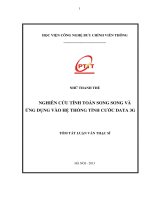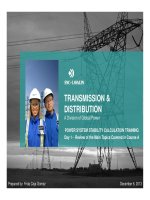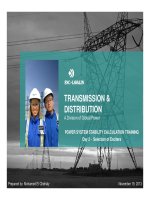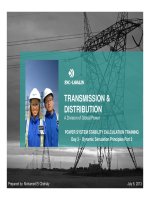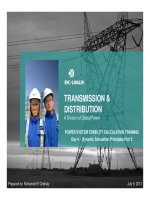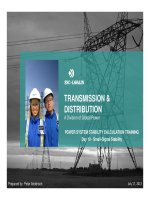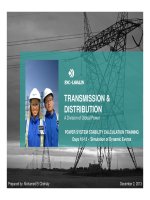Phần 16 KHÓA ĐÀO TẠO TÍNH TOÁN ỔN ĐỊNH VÀ ỨNG DỤNG TRÊN PHẦN MỀM PSSE CHO KỸ SƯ HỆ THỐNG ĐIỆN (Mô hình mô phỏng điện gió trong Phần mềm PSSE)
Bạn đang xem bản rút gọn của tài liệu. Xem và tải ngay bản đầy đủ của tài liệu tại đây (3.84 MB, 69 trang )
TRANSMISSION &
DISTRIBUTION
A Division of Global Power
POWER SYSTEM STABILITY CALCULATION TRAINING
D7
Wi d F Si l ti
D
ay
7
-
Wi
n
d
F
arm
Si
mu
l
a
ti
on
November 25, 2013Prepared by: Mohamed El Chehaly
eBook for You
OUTLINE
2
OUTLINE
• Wind Farms
• Dynamic Models for Wind Farms
• Wind Farm Model Tests
eBook for You
3
WIND FARMS
WIND
FARMS
eBook for You
Power Flow Representation
4
WIND FARMS
Power
Flow
Representation
Wind Turbine Generators modeled as
conventional generators with specific
configurations for Qcontrol
eBook for You
Power Flow Representation
5
WIND FARMS
Power
Flow
Representation
Wind machine control mode
0: if this is not a wind machine (by default)
1: if this is a wind machine that participates in
lt t l ith th l f QT (QMAX) d
vo
lt
age con
t
ro
l
w
ith
th
e va
l
ues o
f
QT
(QMAX)
an
d
QB (QMIN) on the data record specifying the
machine’s reactive
p
ower limits
(
similar to a
p(
conventional machine)
2: if this is a wind machine that participates in
voltage control with specified power factor and the
voltage
control
with
specified
power
factor
and
the
machine’s real power setting (PG on the data
record) used to set the machine’s reactive power
limits
eBook for You
Power Flow Representation
6
WIND FARMS
Power
Flow
Representation
Wind machine control mode
3: if this is a wind machine which operates at a
fixed power with the machine reactive power
output and reactive power upper and lower limits
output
and
reactive
power
upper
and
lower
limits
all equal and set based on the machine power and
the machine’s real power setting PG
Wind machine PF
Ignored if the wind control mode is 0
Is used in setting the machine’s reactive power
limits when the wind control mode is 2 or 3
Negative value may be specified when the wind
Negative
value
may
be
specified
when
the
wind
control mode is 3 to represent leading PF
eBook for You
Types of Wind Farms
7
WIND FARMS
Types
of
Wind
Farms
Type 1: Direct connected conventional
induction generator
Type 2: Wound rotor induction generator
with variable rotor resistance
Type 3: Doubly-fed induction generator
T
y
pe 4: Full size converter unit
y
eBook for You
Type 1 (WT1) Representation
8
WIND FARMS
Type
1
(WT1)
Representation
Type 1: Direct connected conventional
induction generator
eBook for You
Type 1 (WT1) in Power Flow
9
WIND FARMS
Type
1
(WT1)
in
Power
Flow
The wind control mode should be set as 3
(wind machine with fixed Q based on WPF)
User should model properly an equivalent
of a wind farm and take into account the
number of wind machines that will be
lumped into an equivalent machine
lumped
into
an
equivalent
machine
(Equivalent MBASE = N number of
machines x MBASE of one machine)
machines
x
MBASE
of
one
machine)
A vast majority of WT1 includes a set of
capacitors to keep the power factor in
capacitors
to
keep
the
power
factor
in
steady state within range
eBook for You
Type 2 (WT2) Representation
10
WIND FARMS
Type
2
(WT2)
Representation
Type 2: Wound rotor induction generator
with variable rotor resistance
eBook for You
Type 2 (WT2) in Power Flow
11
WIND FARMS
Type
2
(WT2)
in
Power
Flow
The wind control mode should be set as 3
(wind machine with fixed Q based on WPF)
User should model properly an equivalent
of a wind farm and take into account the
number of wind machines that will be
lumped into an equivalent machine
lumped
into
an
equivalent
machine
(Equivalent MBASE = N number of
machines x MBASE of one machine)
machines
x
MBASE
of
one
machine)
A vast majority of WT1 includes a set of
capacitors to keep the power factor in
capacitors
to
keep
the
power
factor
in
steady state within range
eBook for You
Type 3 (WT3) Representation
12
WIND FARMS
Type
3
(WT3)
Representation
Type 3: Doubly-fed induction generator
eBook for You
Type 3 (WT3) in Power Flow
13
WIND FARMS
Type
3
(WT3)
in
Power
Flow
The wind control mode should be set as 2
(wind machine with +/- Q limits based on
WPF)
User should model properly an equivalent
of a wind farm and take into account the
number of wind machines that will be
number
of
wind
machines
that
will
be
lumped into an equivalent machine
(Equivalent MBASE
=
N number of
(Equivalent
MBASE
N
number
of
machines x MBASE of one machine)
No need to add capacitors
No
need
to
add
capacitors
eBook for You
Type 4 (WT4) Representation
14
WIND FARMS
Type
4
(WT4)
Representation
Type 4: Full size converter unit
eBook for You
Type 4 (WT4) in Power Flow
15
WIND FARMS
Type
4
(WT4)
in
Power
Flow
The wind control mode should be set as 2
(wind machine with +/- Q limits based on
WPF)
User should model properly an equivalent
of a wind farm and take into account the
number of wind machines that will be
number
of
wind
machines
that
will
be
lumped into an equivalent machine
(Equivalent MBASE
=
N number of
(Equivalent
MBASE
N
number
of
machines x MBASE of one machine)
No need to add capacitors
No
need
to
add
capacitors
eBook for You
16
DYNAMIC MODELS OF WIND
DYNAMIC
MODELS
OF
WIND
FARMS
eBook for You
Type 1 (WT1) in Dynamics
17
DYNAMIC MODELS OF WIND FARMS
Type
1
(WT1)
in
Dynamics
Three models
WT1G: generator/converter model
WT12T: wind turbine model
WT12A: pseudo governor model
eBook for You
Type 1 (WT1) in Dynamics
18
DYNAMIC MODELS OF WIND FARMS
Type
1
(WT1)
in
Dynamics
WT1G: Generator model
Modeled as conventional induction generator
CIMTR3
Thi d l t k i t t th t fl
Thi
s mo
d
e
l
t
a
k
es
i
n
t
o accoun
t
th
e ro
t
or
fl
ux
dynamics and can be used for single cage or
double ca
g
e machines
g
At initialization, this model calculates the reactive
power consumption of the machine Qact at given
voltage terminal and MW
dispatch and then places
voltage
terminal
and
MW
-
dispatch
and
then
places
a “hidden” shunt on the machine bus terminal with
the size equal to the difference between Qgen and
Qact
eBook for You
Type 1 (WT1) in Dynamics
19
DYNAMIC MODELS OF WIND FARMS
Type
1
(WT1)
in
Dynamics
WT12T: Two-mass representation of the
wind turbine shaft driven train
Shaft
Turbine side
Generator side
eBook for You
Type 1 (WT1) in Dynamics
20
DYNAMIC MODELS OF WIND FARMS
Type
1
(WT1)
in
Dynamics
WT12A: Pseudo governor model
Model that simplifies and generalizes calculation
of the aerodynamic torque
eBook for You
Type 2 (WT2) in Dynamics
21
DYNAMIC MODELS OF WIND FARMS
Type
2
(WT2)
in
Dynamics
Four models
WT2G: generator/converter model
WT2G:
generator/converter
model
WT2E: electrical control model
WT12T: wind turbine model
WT12A: pseudo governor model
eBook for You
Type 2 (WT2) in Dynamics
22
DYNAMIC MODELS OF WIND FARMS
Type
2
(WT2)
in
Dynamics
WT2G: similar to WT1G with controlled
WT2G:
similar
to
WT1G
with
controlled
external rotor resistor
WT12T: same wind turbine model as the
one used for WT1
WT12A: same pseudo governor model as
WT12A:
same
pseudo
governor
model
as
the one used for WT1
eBook for You
Type 2 (WT2) in Dynamics
23
DYNAMIC MODELS OF WIND FARMS
Type
2
(WT2)
in
Dynamics
WT2E: Electrical control model
Value of the external rotor resistance is calculated
This model uses the machine rotor speed and
electrical power as inputs and calculates the
electrical
power
as
inputs
and
calculates
the
portion of the available rotor external resistance to
be added to the internal rotor resistance
eBook for You
Type 3 (WT3) in Dynamics
24
DYNAMIC MODELS OF WIND FARMS
Type
3
(WT3)
in
Dynamics
Four models
WT3G: generator/converter model
WT3G:
generator/converter
model
WT3E: electrical control model
WT3T: wind turbine model
WT3P: pitch control model
eBook for You
Type 3 (WT3) in Dynamics
25
DYNAMIC MODELS OF WIND FARMS
Type
3
(WT3)
in
Dynamics
WT3G: Generator model
Two models: WT3G1 and WT3G2
WT3G2 is recommended model for new dynamic
setups
WT3G2 includes improvements in the original
model WT3G1
The original model WT3G1 is retained for reasons
f b k d tibilit
o
f
b
ac
k
war
d
compa
tibilit
y
eBook for You
